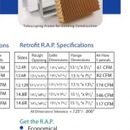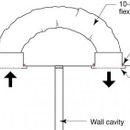Jumper Duct or Transfer Grille for Central Air Return
Does anyone know which performs better, a jumper duct or transfer grille (Tamarack R.A.P to be specific)?
Original plan was to take my central air return in the hallway and stub ducts in the attic to get individual air returns to each bedroom.
Now I am down to the transfer grille or the jumper duct. My 1st choice would be jumper ducts for aesthetics and better air volume capabilities. The only place I can install transfer grilles is above the doors, and the wife wants that tall craftsman trim on the doors 🙄
Can I assume that I will have condensation problems with jumper ducts in an unconditioned attic (Northern Illinois)? If not, flex duct or metal and what R-value duct insulation? Any recommendations on the ceiling boxes?
If the transfer grilles are your preference, which is your preferred manufacturer and model?
Thanks in advance!
GBA Detail Library
A collection of one thousand construction details organized by climate and house part











Replies
Flex has a better chance of keeping noise down, especially if you give it a couple bends along the way. Size it generously - if you know the supply cfm, size the flex for the same flow at 300 fpm in the duct (8" for up to around 100 cfm, 10" for up to around 175, 12" for up to around 250).
But running them through the attic really isn't great, unless you can bury them under more insulation. The most insulated flex you can easily find is R-8, but I'd still want more on top of that. If your attic is loose fill cellulose this is pretty easy to do.
Thanks for your reply. I’ll be blowing in cellulose after this work is done.
How do I determine room cfm, do I base it off the size and number of supplies to a room?
If you don't have design cfm numbers, I'd look at the supply duct(s) and go up 2" if they're round (eg 8" transfer/jumper for a 6" supply), if they're rectangular do a one that's got about 50% more area than the supply. This is all very loosey-goosey but will get you in the ballpark.
Thank you
I'd exceed the sometimes code-min 3 pascals and keep the pressure differential to 1 pascal (definitely not 5). So around 1/2 the CFM that they list.
It completely depends on the numbers, but I get more like 2x the size of the supply for a jump duct that limits room pressure rise to 1 pascal. Ie, 12" jump duct for a 6" supply.
Thanks for the info!
Hi Brandon,
You might be interested in the discussion that follows this Q&A thread: HVAC Return Pathway Options, specifically in Mike Guertin’s comment on Tamarak Thru-Door RAP:
The president of Tamarak lives nearby and he asked me to lunch a couple months back. He brought along samples of their new "Perfect Balance" return air pathway - good idea and one that will appeal to some builders. It's a plastic louvered, internally baffeled hole you cut in the bottom of a door.
He ran through the specs which I'd boil down to a 2 Pa differential at 100 cfm supplied into a closed room. I think that's about the same pressure differential you'd get with a good jump duct and better than a de Keiffer bypass, door undercut or other methods.
The sound transmission is minimal since the bypass is low - about the same as an ordinary door undercut.
I plan to install them on the bathroom doors in my 4 rental houses - I'm sure the tenants will be pretty frank with their opinions.
They list at $29 with quantity discounts. That's very reasonable. And when you figure the materials and labor for alternatives I think this new system may have the edge.
Ideally the "Perfect Balance" will be stocked and installed by door shops making it even easier.
http://www.tamtech.com/userfiles/Perfect_balance_cut_sheet_oct_2010.pdf
http://www.tamtech.com/store/pressure-imbalance-relief-hvac-balanced-ashrae-energystar-stransfer-grille,Product.asp
Kiley,
Thanks for the reply and links, very informative.
Just out of curiosity, what is the reasoning behind installing these in the bathroom doors? My original thought would be that you wouldn’t want returns in the bathroom for “fragrance” reasons 😝